IF TREES COULD TALK, WHAT WOULD THEY TELL US?
by
Chris Maser
Well, trees can talk in a sense because they archive Nature's events in their bodies. Today, however, the language of ancient trees is being lost through the economic liquidation of forests and their replacement with industrially oriented tree farms wherein the historic language of trees has been virtually eliminated. Every language—from that of bees to humans—has evolved in response to the long-term vagaries of Nature. Forest trees are no different.
Therefore, the loss of a language—any language—diminishes our potential ability to understand and appreciate the world we live in, the global ecosystem of which we are an inseparable part. In a more practical sense, if we cannot understand an ecosystem whereon we rely for the services we require from Nature, how can we act positively in our treatment of that system's long-term productivity for our benefit and that of all generations?
Just as a culture evolves a distinctive language, so does each forest type. Whereas, all languages share a commonality within their basic components, some groups of languages have greater similarities than others and can be traced to a common origin. These groups are termed "families," a concept that also applies to the world's forests.
And just as each family of languages is based on and united by commonalities, so are the global components of a forest's language. Nature's governing biophysical principles mediate all events in a forest over the centuries, events that are commonly "read" in the language of trees. Our task is learning to interpret what individual trees, as representative members of a particular forest community, are telling us. As the oldest living beings on Earth, ancient trees, inform us of factual events that took place in centuries past—unless, of course, we cut them all down in the name of short-term economics.
THE LANGUAGE OF TREES
Trees have two separate but related languages, one external, the other internal—both of which symbolize a reciprocal "dialogue" between the tree and its environment. A tree's external "body language" tells us what is going on in a forest today. It therefore represents the ongoing process of change in the environment to which a tree is continually exposed and the tree's response to the ever-shifting conditions. The internal language of "growth rings," on the other hand, is a historical accounting of the outer circumstances encountered during the long years of a tree's life—an autobiographical archive, if you will, enveloped within the tree's protective bark and thus seal off from the outer world.
The External "Body Language" of a Tree
Trees are theoretically immortal because, unlike people and animals, they do not have essential organs (such as hearts, livers, and brains) that wear out and are non-replaceable. Trees produce new functional tissues every year and replace their defenses against such things as harmful fungi and insects. Although they can live for thousands of years, like the bristlecone pine, most trees are weakened and finally die from injury, disease, or both. (One bristlecone pine had lived more than 5,000 years in what is now Great Basin National Park, Nevada—prior to being cut down.) Those species with thick bark or resinous wood tend to live longer than others, but all trees accumulate wounds and infections throughout the cycle of their life or suffer from detrimental changes in their environment.

An acient bristlecone pine in the Sierra Nevada Mountains of California. Note that the tree is only partially alive. Photograph by and courtesy of Sue Johnston.
The southwest wind of an early-April storm blows inland from the Pacific Ocean. High in a Douglas-fir tree a female cone awaits the pollen borne aloft by on currents of air. As millions of pollen grains ride the wind, swirling about the receptive cone, some fertilize the waiting, female gametes.
Over the days and weeks, the seed matures. With the approach of autumn, the seeds are blown from their resting places in the cone by a gust of wind. Landing in an opening on the forest floor, most are eaten by small animals, but some remained to germinate and survive the next two and a half centuries, passing through the stages of adolescents and maturity to enter the portal of old age. And it's in the ancient forest that the external language of trees is most visible.
Live tree
While any agent damaging a tree can kill it outright if its action is extreme enough, in many cases trees survive the initial injury only to be secondarily attacked by such things as fungi or insects. The ultimate fate of a tree, however, depends on its health, the potency of the pathogens attacking it, and its ability to limit or recover from the damage.
Consider that trees are buffeted by wind, which can break off their tops, leaving the stunted apex of such trees as Douglas-fir, Sitka spruce, western hemlock, or western redcedar looking like the victim of a jagged amputation. If the broken area is sufficiently concave to hold water, it is vulnerable to decay organisms, which often instigate the entrance of heart-rot fungi that work their way down into the tree's trunk. Over time, these fungi, along with bacteria, begin to hollow out a live tree.

(Left) The old, broken top of a Douglas-fir with limbs taking over to form a secondary top. (Right) The rotten top of an ancient Douglas-fir. Photographs courtesy of Eric Forsman, USDA Forest Service. As the top assumes a cup-like shape it may serve as a nesting site the Great Gray Owl or, if the upper most branches form a secondary top, for the Northern Spotted Owl.1 Should the decomposed area extend far enough downward into the trunk to form an open-topped, hollow cylinder, it becomes nesting habitat for such birds as Vaux's Swifts. If, however, a hollow-out chamber occupies the fluted butt of an old western redcedar, the resulting cavity may be an ideal site for an overwintering black bear.
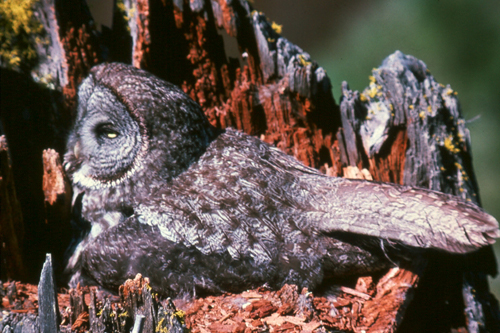
Great gray owl on its nest in the rotting top of an old tree. Photograph courtesy of Ralph Anderson, USDA Forest Service.
In addition to wind, exceptional loads of snow and ice wrought by winter storms may break branches or entire tops of the trees, such as Douglas-fir, mountain hemlock, and Engelmann spruce. Those with asymmetrical crowns are most likely to be damaged because ice builds more heavily on one side than the other. Trees that are subordinate to the tallest trees in a forest, which have the shapes of their crowns influenced by the growth of the tallest trees, are the ones most likely to have asymmetrical crowns broken by ice. Under this circumstance, decay organisms in an old Douglas-fir might created cavities used by such creatures as the red tree vole.

(Left) Red tree mouse. (Right) The nest of a red tree mouse in the boken top of an ancient Douglas-fir. Note the green needles, which are the mouse's main diet. Photographs courtesy of Eric Forsman, USDA Forest Service. In addition, three species of salamanders (clouded salamander, arboreal salamander, and Pacific giant salamander) and the Pacific tree frog are known to climb trees and occupy the nest of tree voles. Both the clouded salamander and the tree frog have been found as high as 66 feet above feet the ground, while the arboreal salamander has been seen in nests as high as sixty feet up. The Pacific giant salamander, on the other hand, was only eight feet high in the tree.2
When neighboring trees fall against one another, they sustain wounds on the sides of their trunks, which strip away the protective bark. If these wounds are deep enough, they attract both wood-boring beetles and disease-causing fungi that enter the trunk by way of the stricken areas. If the tissue in the exposed area dies, it may attract the formation of a carpenter-ant colony, which in turn is food for the Pileated Woodpecker, as evidenced by the large, squarish holes it makes into ant life.

(Left) An adult pileated woodpecker. Photograph courtesy of the USDA Forest Service. (Right) The characteristic holes made by the feeding behavior of a pileated woodpecker. At other times "cold" lightening etches a tree with a spiral pattern that can bite deeply into the wood, without setting it aflame. Now and then, cold lightening simply blasted the top out of a tree.
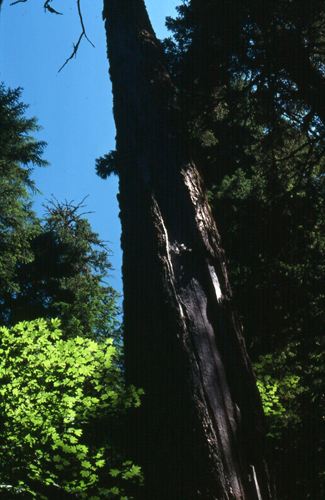
A "cold" lightening strike on an old Douglas-fir leaves its characteristic spiral insignia.
"Hot" lightening, on the other hand, can both scar and burn a tree, as well as starting a whole forest on fire. Each fire burns with a different intensity governed by the species of trees that form the forest composition, as well as type and amount of fuel, which is coupled with topography and the whimsical whim of the wind. In addition, every fire creates a unique forest mosaic of severely burned acres devoid of a living tree connected by corridors and stepping-stone patches, of surviving trees in various stages of health, to areas flames missed altogether.
In the northern climes, on the other hand, thawing and freezing causes some trees to split in what are termed "frost cracks." Others, particularly young trees, may be affected by "sunscald" (also called "southwest injury") when their dormant bark is exposure to the heat of sunlight on the southwest-facing side, which is often reflected off snow. If the temperature is high enough to activate dormant cells during the day, freezing temperatures after sunset kills them and thereby makes them vulnerable to the entrance of decay organisms, and may thus initiate their decline.
Declining tree
The structural dynamics of a dying tree, as well as how it finally dies, determine the biochemical diversity hidden within its deteriorating body, and so greatly affects the ecological processes that incorporate the old tree into the soil from whence it came and the next forest must grow. What goes on inside the body of a dying and dead tree is the hidden biological and functional diversity that is totally ignored by economic valuation. Nevertheless, the fact that trees become injured and diseased, die, and remain in place for decades and centuries is critical to the long-term structural and functional health of a forest as an interactive, organic whole defined not by the pieces of its body, but rather by the interdependent functional relationships of those pieces—the intrinsic value of each piece and its complementary function as they integrate to create the whole.
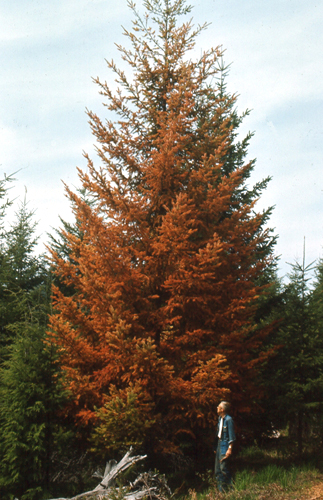
This young Douglas-fir is dying due to griddling by a black bear seeking to eat the its nutritious inner bark or cambium.
To a human, whose body is commencing the onset of old age, there is nothing good about the impending loss of vitality. To the person growing trees as a business, a tree's loss of vigor means potential profits foregone. Declining trees in a commercial forest are viewed as an economic waste if not cut and turned into a usable commodity—hence the economic notion of "salvage logging."
But in a forest, the tree, whose health has run its course and thus begun to fade through injury and disease, has far-reaching, intrinsic value. There are many reasons that account for the biophysical value vested in the twilight of a tree's life.
A tree, whose vigor is diminishing, becomes increasingly important to cavity-nesting birds, such as woodpeckers, which begin testing the wood to discern its readiness for excavation. Moreover, fading trees in which decay has created hollows over the years become habitat of other creatures, such as the western screech owl. In addition, wood-boring beetles make the tree their abode, and, in the process, introduce decay-causing fungi into the wood.
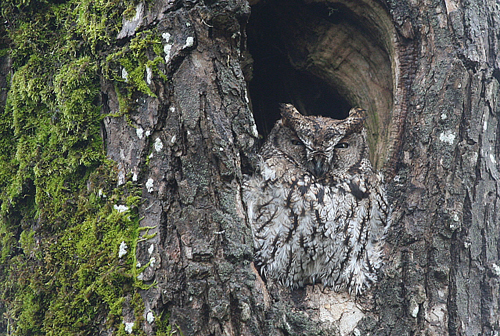
A western screech owl. Photograph courtesy of Eric Forsman, USDA Forest Service.
Yet, even in a state of demise, a tree is still investing energy into its body from the sun, while it simultaneously garners nutrients from the soil. Ultimately, therefore, every tree, regardless of its state of health, serves both as an investment of the sun's energy and a reinvestment of borrowed elements as biological capita into the long-term health of the soil from which it grew and from which each tree in its turn must grow.
Standing dead tree (Snag)
By the time a tree becomes a snag, it often has large pieces of bark attached at the top but loose and curling upward at the bottom. The dark spaces under the bark forms ideal roosting and rearing areas for silver-haired bats, as well of such other species as the little-brown bat and long-eared bat (note the loose bark near the top of the right-hand snag).



As the bark continues to loosen, it begins falling in large and small pieces onto ground surrounding the snag. With time, enough moisture is held under the accumulating bark to form ideal habitat for salamanders.
In addition, snags become adorned with cavities as various cavity-nesting birds pecks out their abodes and decay fungi create their own diversity of hollows. At times, an especially large snag, which survived a fire, acts like a condominium with a spectacular view over the canopy of a younger forest.
Over all, there are 85 species of cavity-nesting birds in North America.3 As will, several species of bats (such as the big brown bat) use cavities for sleeping and rearing their young (both those created by woodpeckers and by decay fungi, especially in old forests4), as do northern flying squirrels, Townsend and yellow-pine chipmunks, deer mice, red tree vole, bushy-tailed woodrats, short-tailed weasels, and marten, to name a few.5
Although a snag may crumble or simply fall over with the passage of years, an ancient tree blown down by the wind is, in many ways, the most complicated stage to explain, stretching as it does over the centuries. To convey even a glimpse into life of such a fallen tree is best done as a story.
Fallen tree
When a tree falls—be it a wind-blown, healthy tree or a decomposing snag—it exerts a series of effects within the forest. The initial response of the forest denizens to the falling of the ancient tree varies. By night a deer mouse, which felt the vibrations sent through the earth by the impact of the old tree, comes to investigate. A passing black-tailed deer stops to eat lichens off the branches, which are suddenly and unexpectedly accessible. By day, a Douglas squirrel climbs onto the old tree and establishes a lookout from which to defend its territory. Birds land on the branches and search for insects or simply warm themselves in the sun coming through the new opening in the forest canopy. Flies land on the tree to sun themselves, and ants include the newly fallen tree in their foraging territories. And within a week, a snowshoe hare finds protection beneath the branches of the old tree's crown.
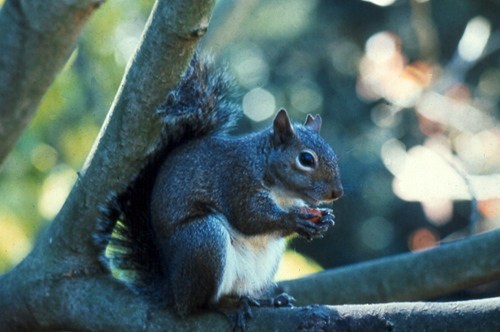
A Douglas squirral, which is also known as a "chickaree." Photograph courtesy of Ronald Roweder, Oregon Department of Fish and Wildlife.
The fallen tree, warmed in the sun, attracts thousands of bark beetles that chew through the bark and thus connect the outside world with the inside of the tree. As they enter and begin to use the tree, they introduce fungal spores and also initiate the nutrient cycle with the first deposit of their bodily wastes.
The character of the available wood varies greatly in different parts of the tree. Proteins are concentrated in the living tissues (phloem—the inner bark and cambium). Carbohydrates are concentrated in the dead woody tissue (xylem). The living inner bark and cambium are more easily digested than is sapwood, but moist sapwood is more digestible than is the drier heartwood. Each portion of a fallen tree therefore supports a characteristic group of insects adapted to a specific microhabitat. The numbers of any one species are also regulated by the quantity and quality of their food supply. Inner bark and cambium furnish the most nutritious food, so this microhabitat is promptly occupied. The area of next greatest importance is the sapwood, then the heartwood, and finally the bark.
Douglas-fir beetles (a member of the bark beetle family), which breed in both live trees and those newly fallen, arrive at the ancient tree. Because they depend on fresh, green tissues of the inner bark and cambium, their larvae must develop rapidly before their perishable habitat and food supply dry out and become chemically and physically altered by other organisms.
A female Douglas-fir beetle attacks the wood early in spring by chewing through the outer bark. In the inner bark and cambium, she chews an egg gallery that is usually two feet wide and has small "grooves" on alternate sides; she then lays ten to 36 eggs in the grooves. When the eggs hatch, the larvae chew lateral feeding galleries through their food supply—the phloem. As the larvae grow, the feeding galleries increase in size.
Larvae pack their feeding galleries with borings (refuse) and frass (feces) as they dine throughout the spring, summer, and autumn. In autumn, each larva creates a pupal cell at the end of its feeding gallery, where it overwinters as a mature larva. Adults overwinter also and begin to emerge in April. The cycle, from egg to sexually mature adult, is about one year long, and one generation is produced annually.
For all its complexities, the life cycle of the bark beetle can be generalized into three stages: reproduction (mating, construction of galleries, laying of eggs, and development of brood), dispersal (flight and host-tree selection), and colonization (aggregation and overcoming host-tree resistance). The beetle leaves the tree only in the dispersal stage.
Ambrosia beetles also enter the fallen tree and live primarily in the sapwood. They differ not only from true bark beetles by constructing galleries that go deep into the wood but also from other wood-boring insects in that they do not eat the wood. Instead, the borings are cast out of the tunnels, where they collect on the surface of the bark or wood as light-colored powder. Adult beetles, depending on the species, construct a variety of tunnels: (1) an open cavity; (2) a long, winding, branched or unbranched cylindrical gallery in which larvae move about freely; and (3) a compound tunnel in which "larval cradles" or small pockets are chewed at right angles along the main channel.
Ambrosia beetles, especially the females, store certain fungi in specialized structures called "mycangia." The fungi, called ambrosia fungi, are introduced into the beetles' galleries during the beetles' burrowing. Particular species of fungi are host specific to certain species of beetles. As the fungi grow, both the adults and larvae eat them. The beetles' requirements, however, are very exacting; if moisture in the galleries is unsuitable, the crop of fungi either fails and the beetles starve or the crop explodes and the beetles smother in their own food. Hence, the stage of decomposition of a fallen tree is critical.
Flat-headed wood-boring beetles, such as the golden buprestid, also arrive at the tree. Some develop in the inner bark and cambium; others feed there only for a short time and then enter the sapwood. Still others go directly into the sapwood and the heartwood. Many flat-headed wood-boring beetles are host-plant specific or at least confine their activities to closely related species of trees.
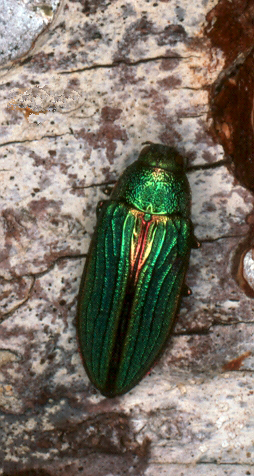
Golden buprestid
The golden buprestid, for example, feeds briefly in the cambium but prefers the sapwood and heartwood of freshly fallen trees. It will, however, inhabit partially to completely seasoned wood, such as snags. A female deposits her eggs in flat masses wedged in cervices in the bark, in cracks in exposed wood, in holes that she creates, or she may be attracted to the pitchy wood of a fire scar. The young hatch and immediately start chewing into the wood. As they grow, their oval tunnels increase in size.
The tunnels range in length from three to fifteen feet from where the eggs hatch to where the larvae mature. As they feed and grow, the larvae pack their tunnels with borings and frass. The larvae mature in two or more years, construct pupal cells near the surface of the fallen tree, overwinter, and emerge in spring as adults. Before laying eggs, the newly emerged adults feed on needles of Douglas-fir, then find a recently fallen tree and start the cycle again.
Although the normal life cycle of the golden buprestid from egg to mature adult is usually two to four years, the length of the cycle is influenced by the quality of a larva's habitat. In poor quality habitat, the life cycle may take a decade or two.
As wood-boring beetles penetrate the fallen tree, and they begin to thrive within it, nature's system of checks and balances is also activated. At first this system is composed primarily of predaceous beetles in the families Cleridae (checkered beetles) and Trogositidae (no common name). The red-bellied checkered beetle, for example, is an important predator of bark beetles in Douglas-fir trees and helps to keep their populations in check. Adult red-bellied checkered beetles prey on the adult bark beetles, and their larvae prey on the larvae of the bark beetles.
A year passes. Needles and bits of lichen from neighboring trees join the snow and rain as it comes through the forest canopy to collect in the fissures in the bark of the fallen tree. Another year passes. Seeds of western hemlock land on the fallen tree and germinate. Those that land in a crevice filled with organic debris from the canopy can grow for a time. But as summer arrives and the forest becomes hot and dry, the seedlings shrivel because their tiny roots cannot yet penetrate the thick, outer bark of the fallen Douglas-fir. A Townsend chipmunk, collecting salal berries in its cheek pouches, scampers along the top of the fallen tree. Suddenly, out of the shadows bounds a long-tailed weasel and bites the chipmunk through the base of the skull. Some of the salal seeds spill onto the tree. Again, it is too soon, and they germinate only to perish.
During the tree's first two years on the ground, an ever-changing variety of animals use it for shelter, food and foraging, and as perches. And throughout each year, the surrounding vegetation continues to grow and change, gradually adding another dimension of ever increasing diversity to the fallen tree.
When the old tree fell, it created a notable hole in the forest canopy. Without further disturbance, the increased light striking the ground will "release" the shade-tolerant understory trees to grow and, with time, to fill in the hole. (Shade-tolerant means that a plant can survive in the shade of another plant; when the shade is removed, however, the plant responds with increased growth). The extent of an opening can be increased considerably if the falling tree starts a domino effect—the successive uprooting and breaking of neighboring trees. The probability of a tree initiating a domino effect increases as the size and vigor of the falling tree increases. A large, healthy tree is more likely to knock over the trees it strikes as it falls than is a decayed snag, even a large one. A snag will most likely break or shatter when hitting a large tree, but it may knock down a small tree if it strikes the tree directly.
Covered and crushed by a falling tree, understory vegetation is either killed by injury or dies from lack of light. Vegetation may also be uprooted or buried by soil as a tree's roots are pulled from the ground. In addition, falling trees create opportunities for new plants to become established. For example, the bare mineral soil of the root pit and mound, and with time the fallen tree itself, presents habitats that can be readily colonized by tree seedlings and other plants.
There are many scenarios in the response of ground vegetation to the falling of a tree because each tree falls differently, further compounded by the tree's size, species, and health, as well as characteristics of the surrounding forest. It is likely that understory vegetation, both existing and potential, will be released when a large Douglas-fir falls because of the large opening created in the canopy that admits light to the floor of the forest. There is also space and resources for plants to become established and grow: first on the mineral soil of the newly exposed rootwad; second on the fallen tree itself as the thick, furrowed bark accumulates litter for a seed bed; and third as the trunk decays, which allows plants to become established in the wood under the bark.
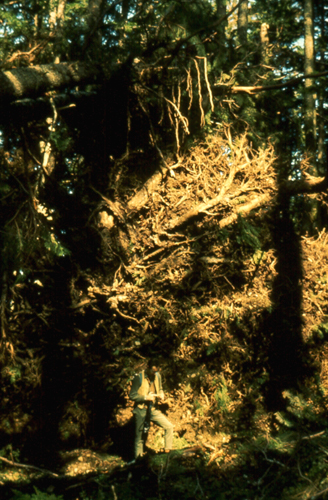
Rootwad of a recently fallen Sitka spruce.
A newly fallen tree interacts only passively with the surrounding forest because its interior is not accessible to plants and most animals. But once fungi and bacteria, which are smaller than the woodfibers, gain entrance, they slowly dissolve and enter the wood cells, and wood-boring beetles, carpenter ants, and termites (which assess wood size by using vibration signals6) chew their way through the wood fibers. Meanwhile, many other organisms, such as plant roots, mites, springtails, amphibians, and small mammals, must await the creation of internal spaces before they can enter. The flow of plant and animal populations and communities, air, water, and nutrients between a fallen tree and its surroundings increases as the tree's decomposition process continues. For example, the water-holding capacity of a large, fallen tree varies by day, season, year, decade, and century, adding yet another dimension of diversity to the forest.
Surface area develops within a fallen tree through physical and biological processes. A tree cracks and splits when it falls and then dries. Microbial decomposition breaks down the cell walls and further weakens the wood. Wood-boring beetle larvae and termites tunnel through the bark and wood, not only inoculating the wood with microbes but also opening the tree to colonization by other microbes and small invertebrates. Wood-rotting fungi produce zones of weakness, especially between the tree's annual growth rings, by causing the woody tissue laid down in spring to decay faster than that laid down in summer. Plant roots that penetrate the decayed wood split and compress it as the roots elongate and thicken in diameter. Because of all this internal activity, the longer a fallen tree rests on the forest floor, the greater the development of its internal surface area. Most internal surface area results from biological activity, the cumulative effects of which not only increase through time but also act synergistically—insect activity promotes decomposition through microbial activity that encourages the establishment of rooting plants.


(Left) Fungi growing out of a decomposing tree that fell some years earlier. Photograph courtesy of James M. Trappe, USDA Forest Service. (Right) As a fallen tree becomes incorporated into the forest soil over the centuries, it acts as a nursery for myriad plants.
Thus, fallen trees offer myriad organisms multitudes of external and internal habitats that change yet persist through the decades. Of the organisms, only the casual observer might notice a few of the fungi, such as mushrooms or bracket fungi. These structures, however, are merely the fruiting bodies produced by mold colonies that run for miles within the tree. Many fungi fruit within the fallen tree; so they are seen only when the tree is torn apart. Even then, only a fraction of the fungi present might be noticed because the fruiting bodies of most appear for only a short time. The smaller organisms, not visible to the unaided eye, are also important components of the forest. We humans do not begin to grasp the notion that microbes and fungi change a forest just a surely as a raging fire, only inconspicuously and more slowly. Theirs is an unseen function that is just as critical, and just as great as any in the forest. We are awed by a towering fir but not by a lowly fungi, and yet it is the fungi that convert the tree to soil and eventually to a new forest.7
The Internal Language of a Tree's Growth Rings
The outer bark of a tree provides primary protection against the desiccation and death of its living tissue and against decay of its structural tissue. A break in the outer bark, whatever the cause, exposes the living tissues to the air, which allows them to dry out and die. The damaged area is "walled off" by the formation of a "reaction zone" within the living tissues around the wound. If a wound is sufficiently severe, the nutrient-rich, moist sapwood, originally protected by the bark, is exposed to decay fungi and wood-boring insects that open channels for still deeper penetration by decay fungi. The decay spreads slowly and is generally limited to the wood formed before the wound occurred. Although most of a tree's external language is variously displayed in the wounds and structural configurations of its outer body, where a wound heals, sealing off the supply of oxygen to pathogens, some of the original trauma becomes internalized and thus subject to a discernable chronology through the language of a tree's growth rings.
The growth rings of trees, can be seen either in a horizontal cross section of a dead tree by cutting through the trunk or in a live tree with the aid of an increment borer, also known as a tree corer, which allows the rings to be "read" without killing the tree. (An increment borer is a metal, T-shaped instrument used to drill into the trunk of a tree until the borer has cored through its approximate center, whereupon the drill is extracted with a tree core.) The growth rings (commonly referred to as tree rings, and occasionally as annual rings) are one of the ways they "speak" to us, thereby telling us their stories.
The anatomy of a tree ring consists of both an inner portion and an outer portion. The inner portion (that which is toward the center of the tree) is formed early in the growing season, when growth is comparatively rapid (hence the wood is less dense—the lighter portion of a ring), and is known not only "earlywood" but also as "springwood" or "late-springwood." The outer portion (that which is toward the bark—the darker portion of a ring), on the other hand, is the denser "latewood" (also termed "summerwood"), which is often produced in the summer, though sometimes in the autumn. Earlywood is used in preference to springwood because the latter term may not correspond to that time of year in climates, such as Alaska or Canada, where earlywood is formed in early summer or even autumn, as in the case with some Mediterranean species.

The cross-section of a Douglas-fir showing both the annual growth rings and a record of damage by black bear over a number of years as they fed on the inner bark or cambium.
The ability to use tree rings to make predictions about the environment of the past is dependent on those factors that affect—limit—plant growth the most. Put differently, the rates at which plant processes occur are only as fast as that allowed by the most limiting condition. If, perchance, rainfall is such an attribute in a given year, then the width of that year's growth ring will reflect the dearth of precipitation accordingly.
Tree rings are most visible in temperate zones, where the seasons are markedly different. Many trees in temperate zones produce one growth ring each year, with the newest being adjacent the bark, thus reflecting a year-by-year record or ring pattern of the conditions in which the tree grew. For example, temperature and soil-water appear to be most highly correlated to changes in width of growth rings. Adequate moisture and a long growing season result in a wide ring, while a drought year may result in a very narrow one. However, alternating favorable and unfavorable conditions, such as mid-summer droughts, can result in several rings being formed within a given year.
Matching the characteristics of tree rings across many samples from an area of similar environmental conditions permits the identification of the exact year each ring was formed, whereas just counting the rings in one or two trees often leads to incorrect conclusions based on inaccurate counts. Matching tree-ring characteristics is important because not all tree rings are equal.
That is to say, trees with naked seeds borne in cone-like structure, such as firs, pines, and sequoias, have wood produced early in the year (earlywood), which appears light in color with cells that have large diameters and thin walls; whereas wood produced in early summer (termed latewood) appears dark in color and has small-diameter cells with thick walls. In contrast, flowering trees, such as magnolias, oaks, and chestnuts, have earlywood cells that have large-diameter vessels and latewood cells with small-diameter vessels. The use of these growth rings works because their characteristics are established annually by seasonal changes in temperature and the availability of moisture, which, in turn, are encoded as variations in the width of a particular ring in the density or structure of the wood, and/or in the chemical composition of the cell walls.8
For example, a series of wide rings speak of wet years, while a cluster of narrow rings tell of dry years. Charcoal records intervals of forest fires, whereas areas of distorted rings may herald a strike of cold lightening as it spiraled down a tree or the feeding of a cambium-hungry black bear when the tree was young.

(Left) A black bear tore these strips of bark off a young Douglas-fir to get at the nutrient-rich cambium. (Right) The grooves were made by the bear's lower, front teeth as it scraped the cambium off the trunk. A bear begins by ripping at the bark with its foreclaws at a slight angle from the vertical, and then work its claws under the loosened bark and pull it off in strips and pieces, two to six inches wide and six to thirty inches long. With the bark removed, the bear then eats the living tissue by scraping it off the trunk with the lower front teeth, which leaves a large number of over-lapping grooves running almost vertically to the axis of the tree.9
INTERPRETING A TREE'S STORY
American astronomer Andrew Ellicott Douglass (1867-1962) began investigating tree rings, in 1901, as a potential indicator of solar cycles. Fired from the Lowell Observatory, Douglass ended up teaching at the University of Arizona at Tucson, where he met archaeologist Clark Wissler, and together they invented the method of dating historic events, known as "dendrochronology" or dating with the aid tree rings. ("Dendrochronology" is derived from the Greek roots: dendros, a tree; chronos, time; and logy from logos, meaning a word or discourse, hence "the study of.")10
Dendrochronology is an interdisciplinary science, and its theory and techniques have many applications, each of which: (1) puts the present in proper historical context, (2) gives us a better understanding of current environmental processes and conditions, and (3) improves our understanding of possible future environmental conditions and issues. Within this context, the practical applications of studying tree rings are numerous:
- archaeology (dendroarchaeology), wherein tree rings are used to help date human activities;
- climate (dendroclimatology), as it relates to the timing of such events as El Niño, La Nina, and the effects of carbon dioxide;
- ecology (dendroecology) as it affects air pollution, forest decline, forest history in general, and so on;
- entomology (dendroentomology), such as the historical timing of insect outbreaks in forests;
- geomorphology (dendrogeomorphology) as it relates to changes in topographical features;
- glaciology (dendroglaciology), which uses data from tree rings to correlate data obtained from ice cores;
- hydrology (dendrohydrology), wherein tree rings are matched with cores from such areas as the bottoms of lakes to give a fuller picture of climate;
- fire chronosequence (dendropyrochronology) is the study of the return intervals of forest fires by using their charred signatures in tree rings.8
As it turns out, archaeology was the first use of tree-ring dating. Douglass used local pine trees to construct a 450-year record of the tree-ring variability. Clark Wissler, an anthropologist interested in the Indigenous Americans of the Southwest, recognized the potential for such dating, and brought Douglass sub-fossil wood from the ruins of pueblos—the traditional communities of Indigenous Americans in the southwestern United States. Unfortunately, however, the wood did not fit into Douglass's record. Thus, over the next twelve years, they built a second prehistoric sequence of 585 years. Then, in 1929, they found a charred log near Show Low, Arizona, which connected the two patterns, thereby making it possible to assign calendar dates to archaeological sites in the American Southwest for over 1,000 years.10
A HISTORY LESSON TAUGHT BY TREES
Although trees may have been long dead, they can still reveal their internal secrets. To illustrate, Dieter Eckstein, a wood biologist at the University of Hamburg, Germany, chronicles several events that took place in the late medieval city of Lübeck, Germany, which was founded about 1150 BCE. There were, for example, two devastating fires, one in 1251 and the other in1276. In addition, the severe outbreak of bubonic plague—also called the "Black Death"—caused the population to crash between about 1340 and 1430.
Not surprisingly, there was a boom in construction immediately after each of the fires, as evidenced by the extensive use of younger trees, which resulted from demand outpacing the ability of the forests to recover. Conversely, after such events as the ninety-year epidemic of plague, which decimated the population of Lübeck, there may be long periods of no construction, followed by the use of very old trees.
Moreover, it was found that rafters in the more expensive house were cut down simultaneously, probably from trees cut at the time the house was built. On the other hand, tree rings in the rafters of other houses spanned a year or more and thus several episodes of logging, which indicates that wood for the house might have been purchased at a market, where logs were stored until they could be sold. In this case it seems probable that wealthy people either had proprietary interest in the forests or could at least contract individually with the owners, while less wealthy individuals lacked such access.
And because imported wood can be identified by its regional variation in the pattern of tree rings, such art objects as the screen at the St. Jacobi Cathedral in Lübeck was made in the late 15th century out of planks taken from 200- to 300-year-old trees from Polish-Baltic forests, probably along established trade routes from the harbors of Gdansk, Riga, or Königsberg. In addition, the organ in the St. Jacobi church and the screen in the Holy Ghost Hospital, both dated to the 15th century. As well, evidence of long-distance trade can be found in objects made from wooden crates or barrels once used to import items from other areas of the world.11 None of the foregoing processes or stories archived in the language of trees would be possible without the ancient forests of the world, populated, as they are, with centuries-old trees to be our teachers.12
ENDNOTES
- (1) Eric D Forsman, E. Charles Meslow, and Howard M. Wight. Distribution and Biology of the Spotted Owl in Oregon. Wildlife Monographs, 87 (1984):1-64 and (2) Eric D. Forsman and Alan R. Giese. Nests of Northern Spotted Owls on the Olympic Peninsula, Washington. Wilson Bulletin, 109 (1997):28-41.
- Eric D. Forsman and James K. Swingle. Use of Arboreal Nests of Tree Voles (Arborimus spp.) by Amphibians. Herpetological Conservation and Biology, 2 (2007):113-118.
- Virgil E. Scott, Keith E. Evans, David R. Patton, and Charles P. Stone. Cavity-nesting birds of North American forests. U.S. Department of Agriculture, Agriculture Handbook 511. (1977) 112 pp.
- Lisa H. Crampton and Robert M. R. Barclay. Selection of Roosting and Foraging Habitat by Bats in Different-Aged Aspen Mixed-Wood Stands. Conservation Biology, 12 (1998):1347-1358.
- Chris Maser. Mammals of the Pacific Northwest: From the Coast to the High Cascades. 1998. Oregon State University Press, Corvallis, OR. (1998) 406 pp.
- Theodore A. Evans, Joseph C. S. Lai, and Emilie Toledano. Termites assess wood size by using vibration signals. Proceedings of the National Academy of Sciences, 102 (2005):3732-3737.
- The preceding story of fallen trees is based on: (1) Chris Maser and James M. Trappe, Technical Editors. The Seen and Unseen World of the Fallen Tree. USDA Forest Service General Technical Report PNW-164. Pacific Northwest Forest and Range Experiment Station, Portland, OR. (1984) 56 pp. and (2) Chris Maser. Forest Primeval: The Natural History of an Ancient Forest. Sierra Club Books, San Francisco, CA. (1989) 282 pp.
- The foregoing discussion of tree rings is based on: (1) Laboratory of Tree-Ring research, The University of Arizona. http://www.ltrr.arizona.edu/dendrochronology.html (accessed October 13, 2008) and (2) http://en.wikipedia.org/wiki/Dendrochronology (accessed October14, 2008).
- Chris Maser. Black bear damage to Douglas-fir in Oregon. Murrelet, 48 (1967):34-38.
- (1) K. Kris. Hirst. http://archaeology.about.com/od/dterms/g/douglassae.htm (accessed November 1, 2008) and (2) K. Kris. Hirst. http://archaeology.about.com/od/dendrochronology/a/tree_rings.htm (accessed January 5, 2009).
- Dieter Eckstein. Human Time in Tree Rings. Dendrochronologia, 24 (2006):53-60.
- Chris Maser. Our Forest Legacy: Today's Decisions, Tomorrow's Consequences. Maisonneuve Press, Washington, D.C. (2005) 255 pp.
© Chris Maser 2010. All rights reserved.




